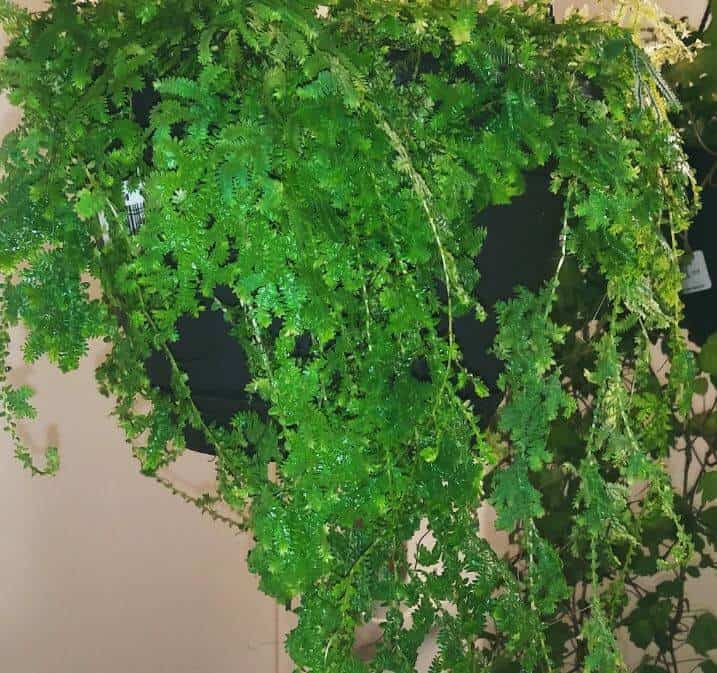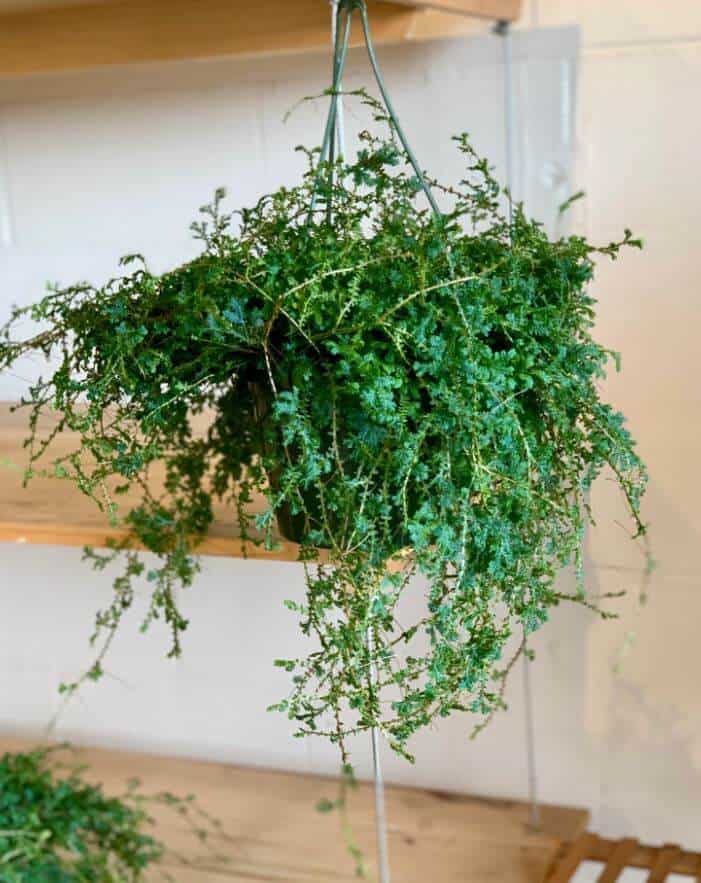Last Updated on September 9, 2023 by a Friendly Gardener
Neither moss nor fern, the rainbow moss plant, more commonly known as “peacock fern”, gets its name from the beautiful bluish-green metallic shades of its leaves, as brilliantly iridescent as a peacock’s feathers.
Many folks consider this plant as moss or fern because of the similarities it shares with the two, in growth habits and appearance.
It’s safe to say that adding this plant to your collection is going to earn you some major bragging rights among friends, family, and other gardening enthusiasts, so here’s everything you need to know about rainbow moss and caring for it!
About Rainbow Moss

Peacock fern, rainbow moss hanging plant, spike moss, club moss, and Selaginella uncinata are all names used to refer to rainbow moss.
These shimmery plants are considered lycophytes or “fern allies” since they’re not actually ferns but closely resemble the latter’s lacy, delicate foliage. However, some folks refer to them as moss because of their growing habits.
The rainbow moss plant is among Mother Nature’s best works—it’s one of the few in the Selaginella genus to have iridescence in its colors. Most others only sport solid shades of green. The plant is at its shiniest during spring when fresh growth occurs, and some of the older leaves can eventually lose their iridescence.
Rainbow moss is quite an old plant species, native to China, and a survivor through centuries. Today, these trailing plants are an excellent addition to terrariums, porches, patios, hanging baskets, dish gardens, and tropical indoor gardens, thriving in humid, moist environments.
They also make excellent coverage plants since they tend to grow low and wide (spreading up to 18 inches) like carpets.
While this eye-catching plant may look posh, it actually makes a superb starter plant, requiring very little care to flourish. However, it should be noted that these plants are slow growers that do not bloom.
Lastly, rainbow moss grows well in hardiness zones 6 to 10, where it can be grown as a semi-evergreen or evergreen coverage plant or as a perennial outdoor plant.
In other zones, the plant can be grown indoors throughout the year, as long as the environment is conducive and the plant is protected from any frost or cold.
Rainbow Moss Care

Here’s everything you need to know about rainbow moss plant care.
Soil Requirements
Humus or organic-matter-enriched soil works wonders for healthy rainbow moss growth. If you’re planting the moss in your outdoor garden, ensure that you leave at least 18 inches of space between the moss and other plants so that its spread is not restricted.
Additionally, given how shallow their roots are, soil mixes that have good water retention capabilities will make rainbow moss plants happy. The ideal pH level is between 5 and 7.3, which means acidic/neutral soil.
Light Needs
Like most ferns and moss, rainbow moss thrives in dark, shaded, and minimally lit spots. Therefore, they can grow well in full shade and partial shade with filtered sunlight, where there is more shade than sunshine.
Any exposure to direct sunlight shouldn’t last more than two hours per day, as excessive sunlight can scorch the plant’s delicate foliage.
If you’re growing them indoors, using grow lights is a good idea—the cherry on top is how gorgeous these plants look under artificial lighting!
Humidity and Temperature Needs

Rainbow moss requires high levels of humidity to grow well, which is why they do well in humid environments like kitchens, bathrooms, and terrariums. Humidity levels between 50% and 90% are recommended for the plant—you can use humidifiers, pebble trays, and several other methods to increase the humidity if it’s insufficient.
When it comes to temperature, these plants do well in temperatures between 55℉ and 85℉, with the ideal range sitting between 65℉ and 75℉. These plants cannot tolerate frost, so if you’re living in an area that experiences frost, make sure you move your rainbow moss indoors.
Watering Needs
Rainbow moss plants are not tolerant to drought and require consistently moist soil. This means regular watering.
Come summer, you’ll have to increase the watering frequency as these plants tend to dry out quickly. Yellowing foliage is a sign of insufficient water and dry soil.
The great thing about these plants, unlike most others, is that it’s hard to overwater them, so don’t be afraid to water your rainbow moss and give it a good soak!
If you’re adding rainbow moss to a diverse terrarium setup, make sure you don’t end up overwatering the other plants while watering your moss. Using drainage-boosting and moisture-retaining supplements, along with a high-quality base, will help balance things out.
Fertilizing Needs
Rainbow moss plants are sensitive to excessive fertilizing—the plant can be burned by excessive amounts and excessive application of fertilizer. If you’ve ensured that the potting soil is rich in organic matter, you don’t need to worry about fertilizing your rainbow moss plant—the soil is sufficient to meet its nutrient needs.
If you must fertilize, do so during spring when new growth emerges, using a diluted water-soluble fertilizer (equal parts water and fertilizer) followed by the second round of application in midsummer.
Propagation

Propagating your rainbow moss is easy through division and stem cuttings.
Cut a chunk of your moss and put it in an airtight environment on a moist surface, such as sphagnum moss. Open the box/chamber occasionally to allow airflow, with an occasional water spray, if required.
Pretty soon, you should see the plant propagating.
The Bottom Line

Rainbow moss has many things going for it—not only is it gorgeous but it’s also pet and human-friendly, with the plant suffering more than your pet if ingested! Additionally, it doesn’t seem to attract many pests and diseases, and you certainly can’t kill it through overwatering.
With a little care, some effort, and a whole lot of love, your rainbow moss plant will grow abundantly, treating you to its visually stunning foliage throughout the year, in addition to being quite the talking point and possibly the highlight of many conversations thanks to its lovely shades!


